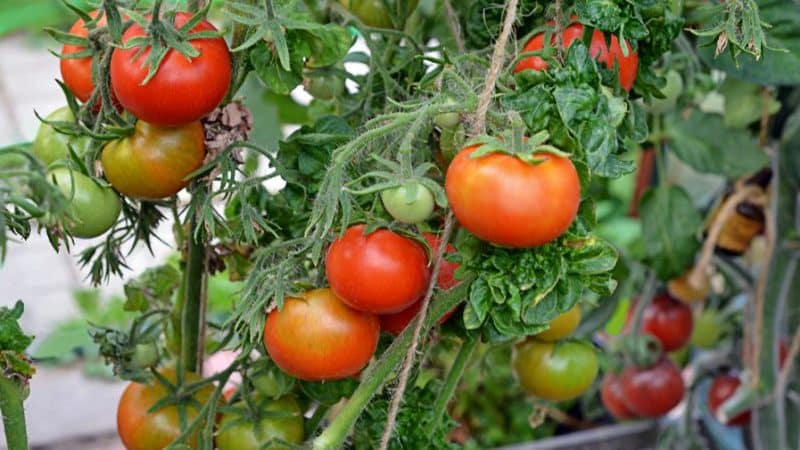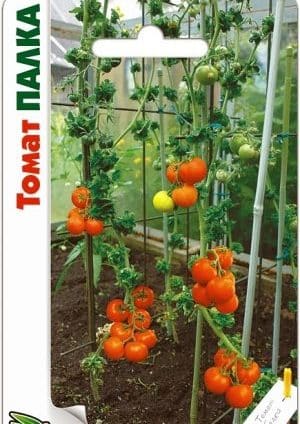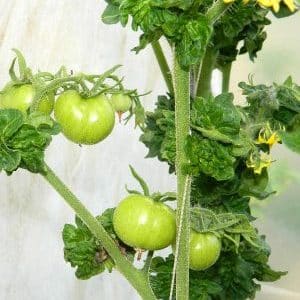Characteristic features of the “Stick” variety that every summer resident will like
There is no gardener who would not like to grow a unique product in his garden. And if a vegetable is unpretentious in care and pleases with its harvest, then it will not have a price. A little-known tomato variety, Palka, meets all these parameters. This culture was developed in the USA in 1958, but only in the 21st century does it begin its journey across our country. Few people know about this variety, and even fewer who grow it.
In the article you will find detailed characteristics and descriptions of the variety of columnar tomatoes.
Description of the variety
Palka tomatoes differ from the usual varieties of tomatoes due to the non-standard structure of the bush.. The long stem, reminiscent of a column, is devoid of leaves and side shoots. The height of the plant can reach 1.5 m. The leaves are small and form a bunch.
The fruits are located on tassels coming directly from the stem. 5-6 fruits grow on one inflorescence. With good care, you can harvest up to 1.5 kg of harvest from 1 bush.

Pros, cons and features of the variety
Advantages of the type:
- the time from sowing seeds to harvesting will be 3.5-4 months;
- the columnar structure of the tomato creates additional advantages when growing;
- suitable for growing in greenhouses and open ground;
- does not require pinching;
- gives a good harvest regardless of the region of growth;
- dense tomatoes are transportable and have a long shelf life;
- resistant to diseases characteristic of the nightshade family;
- the opportunity to collect your own seeds for planting next year.
Compared to other members of the nightshade family, Stick has virtually no disadvantages in growing and caring for it. The only drawback is the weak barrel, which must be tie up. Without regular monitoring, the plant will bend and break.
Fruit characteristics and yield
The absence of side shoots allows bushes to be planted densely, which increases the amount of harvest from 1 m² - it can reach 30 kg.
Tomatoes of the Palka variety are round, elastic, with juicy fleshy pulp, bright red in color.
The weight of one tomato ranges from 50 to 100 g. Even when overripe, it does not crack or fall apart due to its dense shell.
How to grow
If you want to plant Palka tomatoes on your plot, you can purchase seeds in a store, at the market, or collect them yourself.
To collect seeds, you need to choose the right source fruit. It must be ripe, fleshy and fully consistent with the shape of the variety. Working seeds are collected from female fruits: they have a small depression at the bottom.
Growing instructions:
- Select a tomato and treat it with a weak solution of potassium permanganate to avoid contamination of the seeds with possible pathogens.
- Place in a dark and warm place for ripening for a week.
- Upon reaching maturity, the seeds are removed along with the pulp into a clean cup and covered with a piece of material. You need to put them in a dark place. It is forbidden to add water if there is no juice, otherwise the seeds will die.
- After a couple of days, the composition will ferment, the seeds will sink down, and a thin film with bubbles will form on top.
- In a glass, adding warm water several times, rinse the seeds.
- Place the contents on a clean cloth and dry.
- Pour each variety separately into labeled bags.
- Store in a dark, dry place.
You can use your own prepared seeds for 5 years - that’s how long they retain their germination.
Planting seedlings
Seeds are planted 2 months before planting in the garden: depending on the region, from the end of February to the end of March. To grow seedlings, first purchase special boxes or containers.
Suitable soil compositions can be purchased at the store or prepared yourself in the fall. Before planting, the container and soil are treated with a weak solution of potassium permanganate. The seeds are washed with a 1% boric acid solution.
Stages of work:
- Make grooves 1 cm deep across the entire width of the container, every 3 cm.
- Distribute the seeds along the grooves at a distance of 1.5 cm from each other.
- Cover lightly with earth.
- Cover with film.
- Place on a windowsill illuminated by the sun.
- When sprouts appear, get rid of the film.
Picking of sprouts is carried out when 2 curly tufts appear. Tomatoes of the Palka variety should be grown on a sunny windowsill, regularly turning different sides to the sun.
Features of transplanting into the ground
Planting of seedlings is carried out after the final completion of frosts and the establishment of stable sunny weather.
Before planting, it is necessary to loosen the soil well with the addition of compost and wood ash. The permissible distance for planting seedlings is 15 cm between bushes, if 1 sprout is planted. If 2 or 3 sprouts are planted in one hole, then the distance increases to 25-35 cm. The distance between rows is 0.5 m.
Such close proximity will not affect the quality of the crop, since the plant is well lit and ventilated due to the absence of leaves.You can plant up to 30 bushes per 1 m².
Deep planting is not recommended to avoid excessive development of the root system, which will delay the ripening time by 2 weeks.
Attention! Planting in the evening and cloudy days is more favorable for rooting of the sprout.
First, you need to fill the container or box with the seedlings with warm water and leave it to soak. This will help remove the grown seedlings without damaging the roots.
It is necessary to prepare the land for planting, select a suitable site according to the rotation rules. When rotating different crops, the following occurs:
- exchange of microscopic elements necessary for each plant;
- the plant kills its harmful microflora;
- pests that have buried themselves for the winter period, not finding their usual food in the spring, die;
- When plants consume some elements, they release others, thereby enriching the soil.
Fertilizer should be prepared for the soil. Compost, humus and the following solution can be used as fertilizer:
- 25 g superphosphate;
- 10 g ammonium nitrate;
- 15 g potassium chloride;
- 10 liters of water.
Plants in a greenhouse need feeding twice as much as in a garden. The table will help you understand mineral fertilizers.
| A drug | Purpose | Consumption rate | Methods of carrying out work |
| Master (green) | Root feeding | 0.35-0.40 g | Watering every week with a 0.2% solution |
| Megafol (biostimulant) | In stressful situations | 25-30 ml | Spraying under stress |
| Fitolavin-300 | Treatment of seeds before sowing, bacteriosis, powdery mildew | 20 g per kg of seeds | Spraying during the growing season with a 0.2% solution |
| Alirin-B, gamair | Root rot, powdery mildew | 20 tablets | Watering the soil |
| Zenkor, lapis lazuli | Weed control in open ground | 50 g per 10 liters of water | Soaking seeds before sowing in a 0.5% solution |
After applying fertilizers, the soil is dug up.
The procedure for planting in the ground:
- Make grooves of any length and width of 25-30 cm, the distance between them is not less than 0.4 m. The depth of the groove should be convenient for regular watering.
- Fill the grooves with water. Wait until the water is absorbed.
- Carefully, without damaging the root system, remove the seedlings one plant at a time from the box.
- Use a small spatula to make a small hole for the seedlings.
- Plant the seedlings in the hole. It is not necessary to bury the seedlings too deeply so that the forces of the young plant are directed toward growing upward and not toward developing an additional root system.
- The distance between the holes should not be less than 15 cm.
Further care and watering
Further care for Palka tomatoes consists of watering and weeding. It is necessary to regularly treat plants against insects and diseases. Further fertilizer is produced by adding a mixture of sodium, phosphorus and potassium in a ratio of 1/1/1.
A mixture of humus and turf is suitable for greenhouses. The feeding procedure should be repeated no more than 2 times per season.
Reference! Watering is recommended once every 2 days.
If a diseased plant is discovered, the diseased bush should be removed along with a lump of earth.
Planting tomatoes in the same place is allowed no more than once every 3-4 years. Before planting, it is necessary to treat the soil with boiling water.
Prevention of diseases and pests
If plant processing rules are not followed, the yield of the Palka variety can be significantly reduced. Fight with pests Tomato control is carried out not only with pesticides, but also manually.
The fight against the Colorado potato beetle, the worst enemy of tomatoes, consists not only of treating plants against deposited larvae, but also by manually collecting and destroying individuals.
Reviews from gardeners
Marina, 34 years old, Orenburg region: “I accidentally came across the Palka variety in a store and bought it to try. When I saw the first sprouts, I almost threw them away, it seemed to me that there was some kind of disease on them. I decided to wait. The harvest was excellent. I recommend this unusual product to everyone in their garden. It’s interesting to grow new varieties.”
Peter, 54 years old, Krasnodar region: “I bought seeds at the market because of the unusual photo on the package. Out of 10 seeds, 7 sprouted. The seedlings are good and strong. The whole family was delighted with the corrugated leaves instead of the usual ones. I was pleased with the fruits: smooth, fleshy. I immediately decided to collect the seeds for myself and shared them with friends. And the harvest mothballed, it turned out delicious, and the tomatoes store well.”
Veronica, 46 years old, Transbaikalia: “I decided to grow a new variety in a greenhouse to quickly enjoy the results. The bushes are well lit, since there are almost no leaves. The harvest was good, but it didn’t have time to fully ripen; the rest were harvested brown. We made it home. Tomatoes are tasty, without acid, good both fresh and in jars. I made a salad of halved tomatoes with onions and bell peppers, all the halves remained intact. I recommend it to all gardeners, you won’t regret it.”
Conclusion
The new variety of tomatoes Stick has deservedly earned the respect of not only amateurs, but also professionals due to its unpretentious nature, unique stem structure, high productivity and universal use of tomatoes in home cooking.